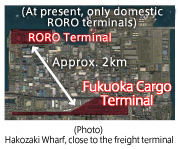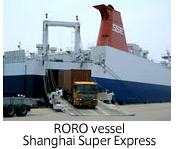Creation of East Asia High Speed Maritime Green Logistics Network and Hubs
Utilizing Japan's close geographical proximity with the Asian mainland, construct the East Asia High Speed Maritime Green Logistics Network and hubs that use low-cost (1/5 or less) and low environmental impact (1/40 or less) international RORO vessels at speeds comparable with air transportation, making transportation to major cities in South Korea and China possible in around 1 day.
Reduction in Customs Clearance Time and Simplification of Handling Procedures through Regulatory Reform etc.。
Realize seamless and speedy international logistics free from the usual hassles associated with transnational shipping
Program of Incentives for Rules to Propose to the Special Synthesis Area
◆Mutual entry to Japanese, Chinese and South Korea chassis
・Mutual entry to Japanese, Chinese and South Korea chassis restricted to areas, terminals and routes
◆Tax assistance for East Asia High Speed Maritime Green Logistics Network and hubs
・Special depreciation, investment tax allowance and tax deductions for shipping operators etc. using RORO vessels etc.
◆Tax assistance for East Asia High Speed Maritime Green Logistics Network and hubs
・Financial support for developing East Asia High Speed Maritime Green Logistics Network
◆Subsidies to help develop international and domestic RORO terminals
・Construct a system that provides lump sum subsidies for developing international and domestic RORO terminals
Merits of RORO vessels
Speeds comparable with air transportation, low cost and low environmental impact
- Fukuoka, situated close to the Asian mainland, is approximately 1,000km from China's major cities. Realize transportation that is possible in around 1 day and speeds comparable with air transportation
- Transportation costs… 1/5 of air transportation or less
- CO2 emissions… 1/40 of air transportation or less
Cargo does not vibrate much (around 1/3 less than container vessels)
- RORO vessels differ to container vessels in that the vehicle with cargo on board propels itself and transfers cargo to the main ship.
- Low impact and vibrations means it is possible to transport goods that are easy to break, such as LCD panels
- Packaging can be simplified, making it possible to reduce costs and lessen the environmental burden

Hakata Port
Hakata Port and Hakozaki Wharf are close to Fukuoka Cargo Terminal, one of the leading large rail freight terminals in Japan


Kitakyushu Port
Kitakyushu Port is a top domestic hub for exporting precision instruments through C&C transportation utilizing excellent connections between domestic ferry and RORO networks and international RORO vessels.



